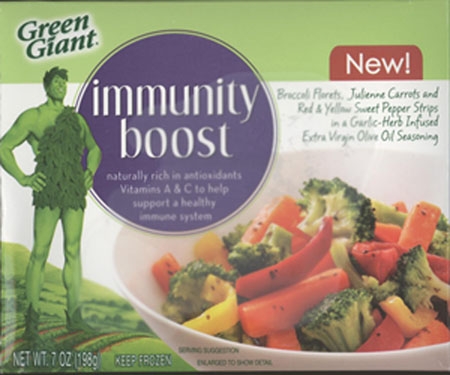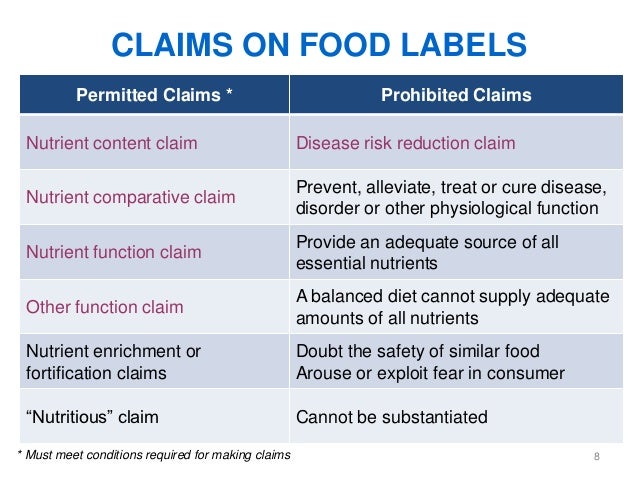43 what are nutrient claims on food labels
Nutrient Claims on Food Labels | Home & Garden Information Center What is a Nutrient Claim? This is a claim concerning a product's nutritional value. It describes the content of a food, including the amount of nutrients, calories, cholesterol, or fiber, but not in exact amounts. Usually placed on the front of the food label, the nutrient claim provides a quick comparison between similar products. Function claims - Health claims on food labels - Food labels ... Acceptable function claims are claims about a food or food constituent that clearly state a specific and scientifically supported physiological effect (e.g. promotes regularity) associated with good health or performance. Claims that state a specific effect provide more useful information for the consumer and are less likely to be misleading or ...
Health and nutrition claims on food labels - FoodTruths Nutrition content claims relate to the presence, absence or level of nutrients or ingredients in foods. For example, 'gluten free' or 'high in calcium'. If a nutrition claim is made there are conditions that need to be met, for example; to claim that a product is a good source of calcium there is a required minimum level of the nutrient ...

What are nutrient claims on food labels
Nutrient content claims - Canadian Food Inspection Agency Comparative nutrient content claims. Conditions for use of comparative nutrient content claims; Comparative claims for vitamin and mineral nutrients; Reformulated products and similar reference foods; Example: steps for evaluating "reduced in fat" Nutrient content claims on foods intended solely for children under two years of age. Advertising ... Understanding Food Labels | The Nutrition Source | Harvard T ... The FDA has approved 12 health claims on food labels such as the relationship between calcium and osteoporosis; sodium and hypertension; fiber-containing grains, fruits and vegetables and cancer; and folic acid and neural tube defects. However, just because a food contains a specific nutrient that is associated with a decreased risk of disease ... nutrient claims on food labels chapter 2 Flashcards | Quizlet PLAY. Match. Gravity. claims on food labels. Click card to see definition 👆. Tap card to see definition 👆. marketing too directed toward health-conscious consumers. claims must comply with FDA regulations. Click again to see term 👆.
What are nutrient claims on food labels. Nutrient content claims: what they mean - Canada.ca Table of nutrient-content claims and what they mean. The food provides an amount of a nutrient that is so small it likely won't have any effect on your body. The food is processed/modified so that it contains at least 25% less of the nutrient when compared with a similar product. Contains no added fats or oils or added butter or ghee, or ... Understanding food labels - Canada.ca Find information on food labels and how to understand them. Learn about nutrition facts tables, serving size, list of ingredients, % daily value and nutrition claims. Food labels & nutritional information | Raising Children Network 23.09.2020 · Food labels are included on all food products, ... These tell you what nutrients the food contains and how much of each nutrient there is. When you buy a packaged food product, ... like ‘low-fat’ on the front of a packet of chips – can be confusing and misleading. Nutrition claims might grab your attention, ... How to read food labels | healthdirect Understanding nutrition claims. Some labels tell you what percentage of the recommended daily intake is provided by 1 serve of the product. This helps you to work out how the food fits into a balanced diet. Read more about recommended daily intakes for adults and recommended daily intakes for children.
Nutrient function claims - Health claims on food labels - Food labels ... For example, the nutrient function claim "Milk helps build strong bones and teeth" is unacceptable, because a nutrient function claim refers to the nutritional function of energy or a nutrient (e.g., calcium) in a food, not a particular food (e.g., milk). An acceptable claim is "Milk is an excellent source of calcium which helps build strong ... Nutrition content claims and health claims - Food Standards Nutrition content claims. Nutrition content claims are about the content of certain nutrients or substances in a food, such as 'low in fat ' or 'good source of calcium'. These claims need to meet certain criteria. For example, food with a 'good source of calcium' claim needs to contain at least the amount of calcium specified in the Standard. Label Claims for Conventional Foods and Dietary Supplements Mar 07, 2022 · Among the claims that can be used on food and dietary supplement labels are three categories of claims that are defined by statute and/or FDA regulations: health claims, nutrient content claims ... What is the purpose of the health claims nutrition claims on food labels? Click to see full answer. Regarding this, what is the purpose of nutrient claims on food labels? "Nutrient content claims" are used for two purposes: To describe the level of a nutrient in the product using terms such as free, high, and low or. To compare the level of a nutrient in a food to another food using terms such as more, reduced, and lite. ...
Understanding food labels - Canada.ca Find information on food labels and how to understand them. Learn about nutrition facts tables, serving size, list of ingredients, % daily value and ... other nutrient content claims. Percent daily value. How to calculate % daily value on a nutrition facts table, how to use % daily value. About food labels. What has to be included on food ... What are Nutrient Content Claims? - Nutrition Label Review Good: means the product contains 10-19% of the Daily Value of a nutrient (i.e. protein, fiber, or vitamin or mineral). Synonyms include "contains and provides". High: means the product contains 20% or more of the Daily value of a nutrient (i.e. protein, fiber, vitamin or mineral). Synonyms include "excellent source and rich in". Notes to remember about "good" and "high" claims ... Use food labels - Canada's Food Guide Oct 14, 2020 · Benefits of using food labels. Food labels provide information you can use to make informed choices about foods and drinks at the grocery store and at home. Food labels can help you: compare and choose products more easily; know what ingredients a food product contains; choose products with a little or a lot of the nutrients that are of ... Nutrient Claims on Food Labels - Truly Good Foods Nutrient Claims on Food Labels - Truly Good Foods Nutrient Claims on Food Labels July 19, 2018 Nutrient claims describe the content of a food, including the amount of nutrients, calories, cholesterol or fiber, but not in exact amounts. Usually on the front of the food label, the nutrient claim provides a quick comparison between similar products.

Kraft, General Mills, Dole, & Others Ripping Off Consumers with Bogus Immunity Claims | Center ...
Understanding Food Labels and Health Claims - Nutrition Essentials This label is called a Nutrition Facts panel, which gives information on the number of servings per container, the number of calories per serving, and certain nutrients. Specifically, it lists the macronutrients and four of the most important micronutrients people need to pay special attention to, such as Vitamin D, Calcium, Iron, and potassium.
In Pictures: 29 Foods With "Health Claims" That Are Deceiving You And Making You Sick - Modern ...
Label Claims for Food & Dietary Supplements | FDA Mar 07, 2022 · Among the claims that can be used on food and dietary supplement labels are three categories of claims that are defined by statute and/or FDA regulations: health claims, nutrient content claims ...
Nutrient Claims on Food Labels Flashcards | Quizlet danaolsen2013 Nutrient Claims on Food Labels STUDY PLAY calorie free less than 5 kcal/serving low calorie 40 kcal or less per serving than the reference food reduced calorie 25% less kcal per serving than the reference food light/lite
Nutrition claims - Food Safety A claim that a food contains a nutrient or another substance, for which specific conditions are not laid down in this Regulation, or any claim likely to have the same meaning for the consumer, may only be made where the product complies with all the applicable provisions of this Regulation, and in particular Article 5.
Nutrition, health and related claims - Food Standards Standard 1.2.7 - Nutrition, health and related claims in the Food Standards Code (the Code) set out requirements for making nutrition content and health claims about food. Find out more about the Standard and the different types of claims. The Implementation Subcommittee for Food Regulation (ISFR) has guidance on how to comply with Standard 1.2.7.
Nutritionist Pro™ | Nutrition Food Labels Nutrient Content Claims See if your food item qualifies for any nutrient claims such as Low Fat, Sugar Free or more. Ingredient list and Allergens — Easily identify and update ingredient list or allergens present in foods. Nutrient % and Rounding Rules — Label displays both unit (g, mg, mcg) values and % as required by regulations.
Nutrient Content Claims on a Food Label - LabelCalc The food product nutrition content must meet the strict guidelines and parameters set forth by the FDA in order to accurately make these nutrient content claims on a food label. For a more in-depth look at nutrient content claims, download this PDF. A Quick Reference Summary of Parameters
Decoding Food Label Claims: The Lowdown on Package Promises What is a Food Claim? Three categories of claims can appear on food labels: A nutrient content claim refers to the amount of nutrients within the food, such as "low-fat" or "rich in vitamin C." Nutrient content claims have a multitude of rules; for example, the font size of a claim can be no larger than two times the name of the product.



Post a Comment for "43 what are nutrient claims on food labels"